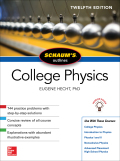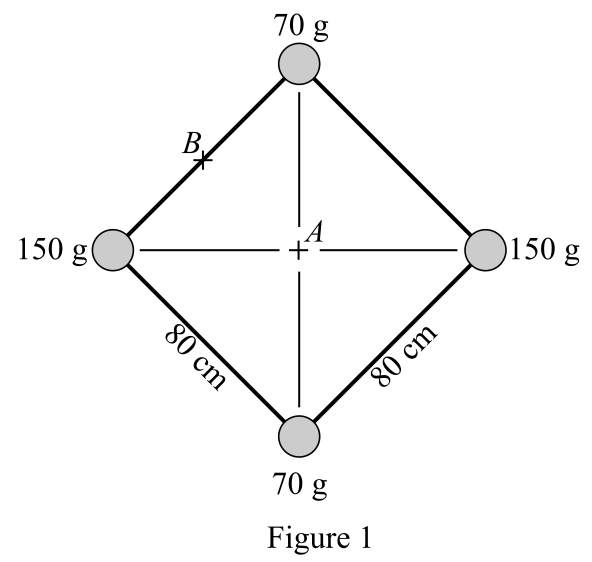
Concept explainers
Figure 10-13 shows four masses that are held at the corners of a square by a very light frame. What is the moment of inertia of the system about an axis perpendicular to the page (a) through A and (b) through B?
![Chapter 10, Problem 57SP, 10.57 [I] Figure 10-13 shows four masses that are held at the corners of a square by a very light](https://content.bartleby.com/tbms-images/9781259587399/Chapter-10/images/87399-10-57sp-question-digital_image59.png)
Fig. 10-13
(a)
The moment of inertia of the system shown in Fig. 10.13, about an axis perpendicular to the page through A.
Answer to Problem 57SP
Solution:
Explanation of Solution
Given data:
The system of four masses are shown as follows:

Formula used:
Write the expression of moment of inertia of a mass system about an axis is given as follows.
Here,
Write the expression of Pythagoras theorem in right angled triangle to find the distance of point mass from the axis.
Here,
Explanation:
Redraw the diagram of the system show provided in the question:

From fig. 1, infer that all the point masses are at equal distance from the axis perpendicular to page through A. Let the distance of point masses from the axis be
The expression of distance of point masses from axis perpendicular to page through A is,
Here,
Substitute
Solve for
The expression of moment of inertia about a given axisfor a mass system is as follows,
Since, the perpendicular distances of all the point masses from the given axis are equal, therefore, the expression of the distance of all point masses from the given axis is,
Substitute
Substitute
Conclusion:
The moment of inertia of the system about an axis perpendicular to the page through A is
(b)
The moment of inertia of the system shown in Fig. 10-13, about an axis perpendicular to the page through B.
Answer to Problem 57SP
Solution:
Explanation of Solution
Given data:
The system of four masses that are held at the corners of a square by a very light frame as shown in fig. 1.
Formula used:
Write the expression of moment of inertia about a given axis.
Here,
Write the expression of Pythagoras theorem in right angled triangle to find the distance of point mass from the axis.
Here,
Explanation:
From fig. 1, infer that the distance of point mass
The expression of distance of point mass,
Here,
Substitute
The expression of Pythagoras theorem in right angled triangle to find the distance of point mass from the axis B.
Here,
Substitute
Solve for
Further, solve the expression.
The expression of moment of inertia about a given axis is,
Substitute
Substitute
Conclusion:
The moment of inertia of the system about an axis perpendicular to the page through B is
Want to see more full solutions like this?
Chapter 10 Solutions
College Physics
- If the torque acting on a particle about an axis through a certain origin is zero, what can you say about its angular momentum about that axis?arrow_forwardA solid cylinder of mass 2.0 kg and radius 20 cm is rotating counterclockwise around a vertical axis through its center at 600 rev/min. A second solid cylinder of the same mass and radius is rotating clockwise around the same vertical axis at 900 rev/min. If the cylinders couple so that they rotate about the same vertical axis, what is the angular velocity of the combination?arrow_forwardFor a particle traveling in a straight line, are there any points about which the angular momentum is zero? Assume the line intersects the origin.arrow_forward
- What if another planet the same size as Earth were put into orbit around the Sun along with Earth. Would the moment of inertia of the system increase, decrease, or stay the same?arrow_forwardThe position vector of a particle of mass 2.00 kg as a function of time is given by r=(6.00i+5.00tj), where r is in meters and t is in seconds. Determine the angular momentum of the particle about the origin as a function of time.arrow_forwardFigure 13.24 shows a particle with momentum p. Using the coordinate systems shown, determine the direction of the angular momentum of the particle around the origin in each case, and write expressions for L, using symbols defined in Figure 13.23. FIGURE 13.24arrow_forward
- A uniform disk of mass m = 10.0 kg and radius r = 34.0 cm mounted on a frictionlessaxle through its center, and initially at rest, isacted upon by two tangential forces of equalmagnitude F, acting on opposite sides of itsrim until a point on the rim experiences acentripetal acceleration of 4.00 m/s2 (Fig.P13.73). a. What is the angular momentumof the disk at this time? b. If F = 2.00 N, howlong do the forces have to be applied to thedisk to achieve this centripetal acceleration? FIGURE P13.73arrow_forwardCan you assign an angular momentum to a particle without first defining a reference point?arrow_forwardA space station is coast me ted in the shape of a hollow ring of mass 5.00 104 kg. Members of the crew walk on a deck formed by the inner surface of the outer cylindrical wall of the ring, with radius r = 100 m. At rest when constructed, the ring is set rotating about its axis so that the people inside experience an effective free-fall acceleration equal to g. (Sec Fig. P11.29.) The rotation is achieved by firing two small rockets attached tangentially to opposite points on the rim of the ring, (a) What angular momentum does the space station acquirer (b) For what time interval must the rockets be fired if each exerts a thrust of 125 N?arrow_forward
- The precession angular velocity of a gyroscope is 1.0 rad/s. If the mass of the rotating disk is 0.4 kg and its radius is 30 cm, as well as the distance from the center of mass to the pivot, what is the rotation rate in rev/s of the disk?arrow_forwardIf the angular acceleration of a rigid body is zero, what is the functional form of the angular velocity?arrow_forwardThe two balls are attached to the light rigid rod, which is suspended by a cord from the support above it. If the balls and rod, initially at rest, are struck with the force F = 11.5 lb, calculate the magnitudes of the corresponding acceleration of the mass center and the rate at which the angular velocity of the bar is changing.arrow_forward
 University Physics Volume 1PhysicsISBN:9781938168277Author:William Moebs, Samuel J. Ling, Jeff SannyPublisher:OpenStax - Rice University
University Physics Volume 1PhysicsISBN:9781938168277Author:William Moebs, Samuel J. Ling, Jeff SannyPublisher:OpenStax - Rice University Physics for Scientists and Engineers: Foundations...PhysicsISBN:9781133939146Author:Katz, Debora M.Publisher:Cengage Learning
Physics for Scientists and Engineers: Foundations...PhysicsISBN:9781133939146Author:Katz, Debora M.Publisher:Cengage Learning Glencoe Physics: Principles and Problems, Student...PhysicsISBN:9780078807213Author:Paul W. ZitzewitzPublisher:Glencoe/McGraw-Hill
Glencoe Physics: Principles and Problems, Student...PhysicsISBN:9780078807213Author:Paul W. ZitzewitzPublisher:Glencoe/McGraw-Hill Principles of Physics: A Calculus-Based TextPhysicsISBN:9781133104261Author:Raymond A. Serway, John W. JewettPublisher:Cengage Learning
Principles of Physics: A Calculus-Based TextPhysicsISBN:9781133104261Author:Raymond A. Serway, John W. JewettPublisher:Cengage Learning Physics for Scientists and Engineers, Technology ...PhysicsISBN:9781305116399Author:Raymond A. Serway, John W. JewettPublisher:Cengage Learning
Physics for Scientists and Engineers, Technology ...PhysicsISBN:9781305116399Author:Raymond A. Serway, John W. JewettPublisher:Cengage Learning




